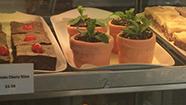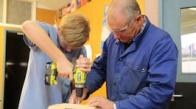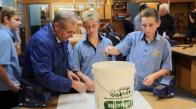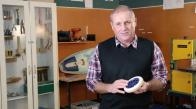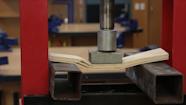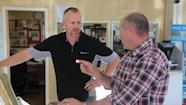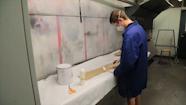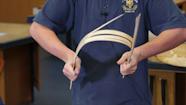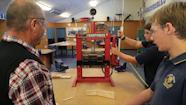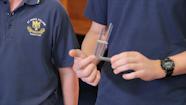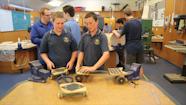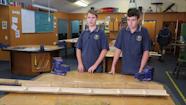Matt Spencer of Walter Findlay outlines the quality measures taken at checkpoints during the production process.
Food processing and testing in a national environment – Walter Findlay Ltd
Transcript
Matt Spencer: Being in a process is obviously sourcing your ingredients so we have what we call an approved suppliers list so that we know where our ingredients are coming from – we’re not getting it from one guy one week and a different person the next week. So that’s all done by a quality manager, so he’ll find out where they're sourcing their ingredients through. He’ll audit them at times, to make sure their processes are up to specification so that we know that our ingredients are up to specification.
Once the ingredients are sourced it’s obviously all brought into the bakery and we then start with the weigh-up process of the product, which is of the minor ingredients, your yeast, flour, sugar, salts, all those sort of things. Basically the staff have recipes that they need to follow, without making too big a variations with ingredients. There is certain levels you’re not allowed to go above. For say iodised salt, it’s 1.7 percent is the highest level we’re allowed to put in the bread, so they can’t be putting anything more in.
From there, we’re into the mixing stages and we’ve run to have a few quality, different quality checks that we’ll do ... where we’re checking the dough temperature. We don’t want the dough to be too warm otherwise it will start to processing too fast and you’ll lower your standard of quality within your product itself, so we’ll control our dough temperature by adding ice. By adding ice, we’re able to keep the dough temperature down mostly the more you add, the cooler it will get. So basically what we’re doing is we’re pulling the water out. Instead of using water, we’re just using solid ice, so if we want 61 percent water we’ll use say 10 percent ice and 51 percent of just normal chilled water to reach our target. We sort of have targets that we aim for. Most flour has an absorption rate and how much water it’ll take and on average that’s about 63, so that’s generally the target that we aim for within the doughs as water percentages. If your dough is too warm, like I said, you’ll just run into problems. With processing problems, it will become sticky as all the active ingredients in the dough will start reacting faster than what they should.
From the doughing process it’s onto the weighing and scaling process. The next stage of the process is the scaling of the dough pieces. Basically the machine does all the work for you. It will just making fine adjustments to the machine, checking the dough pieces, maybe 10 to 15 dough pieces out of a mix, which is generally about 120 loaves of bread. We’ll just take them off the line, weigh them, make sure they’re up to the minimum weight required. If they’re under we’ll take them off, make the adjustments to the machine, reweigh the dough pieces again to get us to our minimum weight, and from there on it’s over to the moulding processing.
Over at the moulding we’ll be checking to make sure the end pieces are sealed, the full pieces of the dough are sitting correctly in the tin. We don’t want them all over the place, damages to the structure of the internal loaf of bread. Once that processing is going through fine, it goes into the proving stage of the dough. So when the proven bread comes out we’ll be checking dough temperature again, making sure it’s not got too hot, it’s not too cold, so then they know all the ingredients are reacting and working properly. Basically we’re looking for a dough to come out of the prover at about 38 to 39 degrees and from there it’s into the baking process. So through the oven, as it’s coming out of the oven we’re again looking for a temperature between 96 and 98 degrees, so that we know that it’s baked through.
From the oven it will go into a cooling stage. It’s coming out of the cooling stage we’re checking the temperature again to make sure that we’ve got a final loaf temperature of approximately 26 to 30 degrees. Anything warmer than that and it’ll start sweating in the bag. Obviously if it starts sweating in the bag it’s going to cause mould to grow or start earlier in the process than what it should, and you’ll find that it won’t reach your best-before date without growing mould.
We’re then working to the slicing area, where we’re checking we’ve got the correct number of slices required for a loaf of bread, whether it be 21 and 2 crusts, or 17 and 2 crusts for toast or sandwich. After that process into the bag so you’ve got to check to make sure that you’ve got the correct packaging to start off with, the bags been closed properly, you’ve got a best-before date on the tag, that it is clear and legible.
From there it will pass through a metal detector to make sure that it hasn’t got any metal contaminants within the bread and then it goes across a final weight checker to again make sure that you’ve reached your minimum target weight that’s on each bag. From there it is into the bread crates and ready to be picked and packed into different orders, ready for the drivers to come and deliver in the morning.
So the bakery operates 7 days a week with 363 days of the year, except for Christmas Day and Good Friday and we have reasonable hours that we work, well most of us do, where we start processing the bread normally between sort of half past 8 and 9 o’clock in the morning. As the process continues we have staggered starts, so different people starting at different times from the mixers through to the slicers where the slicers will start three and a half hours afterwards when the bread has been finally cooled down properly.
From that process we also have another group of people that come in, and they all come in at about normally about 10 o’clock at night and they’ll actually pick all the orders, make up the shops' orders for them, and then the drivers will come in and generally start about 2 o’clock in the morning and they’ll do an 8 to 9 hour shift, delivering bread to wherever is required in the Gisborne district, Wairoa, and up the coast.
Related videos
A year 13 student talks about her career pathways (00:55)
A student shares about combining her interests in law and food technology.
Authentic modern food contexts in senior programmes (03:28)
Ritu Sehji empowers her senior food technology students by teaching about culinology and the work of Heston Blumenthal.
Combining knowledge and practice (01:58)
Steve Andrew explains how understanding materials is essential for effective technological practice.
Linking hands-on experiences and understandings (03:54)
Hands-on experiences allow the students to see materials understandings in action.
Play, experiment, explore (02:55)
Steve Andrew lets the students see, feel, and play with products to develop their understandings in materials.
Finding materials to meet the specs (02:36)
Steve Andrew shares how students identify material specifications in a brief and then test materials to find those that are suitable....
School–industry relationship cuts both ways (03:36)
Steve Andrew and Terry Rillstone describe the way the relationship between St John's College and The Shop has benefits for them both....
Pushing the boundaries with materials (02:53)
Steve Andrew describes how his senior students have the confidence to select and work with unfamiliar materials.
Exploring unfamiliar materials (02:44)
Year 12 students from St John's College describe what they know about bamboo and how they are applying this knowledge to their projects....
Students and teachers talk about testing materials in year 11.
Manipulating, forming, and transforming
Students in year 10 describe manipulating, forming, and transforming materials.
Evaluating materials for an outcome
Steve Andrew and students talk about using their knowledge to test materials for their projects at year 12.
Year 10 students describe some of the attributes for the snake skates they are developing.
Senior students select their own issues
Year 12 students talk about the issues that they have selected for their projects.


